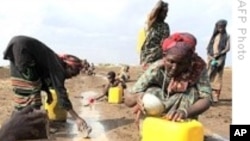<!-- IMAGE -->
The Kenya Meteorological Department says the much-anticipated El Niño rains have arrived in the drought-stricken African region. Humanitarian groups warn the long-awaited precipitation will provide little immediate relief to the troubled areas and will likely cause an array of new ills.
A vast region of East Africa has been suffering under an persistent drought that has left tens of millions in need of emergency food relief.
For months observers have been predicting the regional arrival of the El Niño rains, which are caused every few years by a periodic temperature change in surface ocean waters, resulting in temporary shifts in regional weather patterns.
Meteorologists predict these rains will continue in some areas until January, hitting regions in Kenya and southern and central Somalia most severely. This El Niño cycle is expected to be mild or moderate compared to the downpours of 1997 and 1998, which caused massive flooding and damage in East Africa.
Mired in the severe drought, many have naturally looked forward to the expected phenomenon as an end to their region's parched misery. Some Kenyan authorities have expressed guarded optimism about this year's El Niño and have urged farmers to take advantage of the extra rains in order to maximize crop production and begin closing the country's massive food shortfall.
But aid groups are preparing for a new round of humanitarian crises, expecting that in some areas the drought will likely give way to flash floods.
U.N. Office for the Coordination of Humanitarian Affairs regional spokesman Jens Laerke says the El Niño rains could quite feasibly worsen conditions.
"The end result from a humanitarian perspective might actually be worse in the sense that if you have flooding, immediately after the flooding you have stagnant water, and with that all the associated water-borne diseases such as cholera, increase in malaria, even Rift Valley fever, as we have seen in the past," said Laerke.
The U.N. agency is estimating 750,000 people in Kenya could be temporarily dislocated from flood-related causes, 150,000 of these are already refugees. In Somalia, 450,000 across the Juba and Shabelle regions could be affected.
Laerke says the rains are expected to be localized.
"What we expect is that some areas will by hard hit, we will see flooding. Other drought-stricken areas will not get a drop of rain. Some areas will get rain, and the crop production is expected to improve," added Laerke. "But the result of that will not be immediate."
For livestock herders, the rains may stem the tide of dying cattle. But others warn cattle deaths may initially spike upwards, as emaciated cows prove unable to withstand the temperature shock of the rainfall.
The U.N. agency expects the rain to do little in the immediate short term to help lessen the region's food crisis, but says those farming areas that do receive a moderate amount of rain could reap the benefits by early next year.
